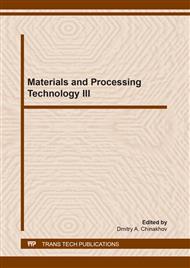[1]
Allan Manalo, Chamila Sirimanna, Warna Karunasena, Lance McGarva, and Paul Falzon, Pre-impregnated Carbon Fibre Reinforced Composite System for Patch Repair of Steel I-beams. Construction and Building Materials 2016. V.105. P.365–376.
DOI: 10.1016/j.conbuildmat.2015.12.172
Google Scholar
[2]
Amr M.I. Sweedan, Khaled M. El-Sawy, Mohammed M.A. Alhadid, Interfacial behavior of mechanically anchored FRP laminates for strengthening steel beams. Journal of Constructional Steel Research 80 (2013) 332–345.
DOI: 10.1016/j.jcsr.2012.09.022
Google Scholar
[3]
Aronovich D. A., Varlamov V. P., Voitovich V. A. et al. Adhesion in mechanical engineering. Moscow: NaukaiTechnologiya. 2005.554 p.
Google Scholar
[4]
P. Colombi, A. Bassetti, A. Nussbaumer, Delamination effects on cracked steel members reinforced by prestressed composite patch. Theoretical and Applied Fracture Mechanics 39 (2003) 61–71.
DOI: 10.1016/s0167-8442(02)00138-6
Google Scholar
[5]
E. Ghafoori, N.J. Aljabar, X.L. Zhao, R. Al-Mahaidi, M. Motavalli, Y.C. Koay, Fatigue tests on UHM-CFRP strengthened steel plates with central inclined cracks under different damage levels. Composite Structures 160 (2017) 995–1006.
DOI: 10.1016/j.compstruct.2016.10.122
Google Scholar
[6]
G. Lesiuk, M. Katkowski, M. Duda, A. Królicka, J.A.F.O. Correia, A.M.P. De Jesus, J. Rabiega, Improvement of the fatigue crack growth resistance in long term operated steel strengthened with CFRP patches. Procedia Structural Integrity 5 (2017) 912–919.
DOI: 10.1016/j.prostr.2017.07.109
Google Scholar
[7]
Hai-Tao Wang, Gang Wu, Yun-Tong Dai and Xiao-Yuan He, Determination of the bond–slip behavior of CFRP-to-steel bonded interfaces using digital image correlation. Journal of Reinforced Plastics and Composites 2016, V. 35(18). P. 1353–1367.
DOI: 10.1177/0731684416651342
Google Scholar
[8]
Ustinov A., Kopanitsa D., Abzaev Yu., Klopotov A., Koshko B., Kopanitsa G. Study of deformations evolution near-surface layers of adhesive joints // AIP Conference Proceedings. 2017. N 1800. N 1. P. 040007 (1–6). https://doi.org/10.1063/1.4973048.
DOI: 10.1063/1.4973048
Google Scholar
[9]
Tretyakova T.V., Tretyakov M.P., Wildeman V.E. Assessment of measurement accuracy using a video system for analysis of displacement and deformation fields. Bulletin of the Perm State Technical University. Mechanica. 2011. No 2. P. 92-100.
Google Scholar
[10]
Majidi H. R., Javad S. M., Berto R. F. Failure assessment of steel/CFRPD double strap joints // Metals. 2017. V. 7. P. 255-265.
DOI: 10.3390/met7070255
Google Scholar
[11]
Kałuża M., Hulimka J. Methacrylate adhesives to create CFRP laminate-steel joints – Preliminary static ND fatigue tests // Procedia Engineering. 2017. V. 172. P. 489–496.
DOI: 10.1016/j.proeng.2017.02.057
Google Scholar
[12]
Zuev L.B. On the waves of plastic flow localization in pure metals and alloys. Ann. Phys. 2007. V. 16. N 4. P. 286-310.
DOI: 10.1002/andp.200610233
Google Scholar
[13]
Sytov V. A., Verstakov A. E., Voronin A. E. A systematic approach to the problem of creating adhesive joints in tribotechnology. Questions of Materials Science, 2006, No. 2 (46). P.204-211.
Google Scholar
[14]
Kopanitsa D.G., Ustinov A.M., Potekaev A.I., Klopotov A.A., Marchenko E. S. Change in the stress-strain state of subsurfase layers of steel during loading. Russian Physics Journal. 2018. V. 60, No. 9. Р.1577-1585.
DOI: 10.1007/s11182-018-1254-4
Google Scholar
[15]
Timoshenko S. Strength ofmaterials. Part I. Elementary Theory and Problems. Northern University Press. Toronto, New York, London. 1940. 510 p.
Google Scholar
[16]
Shnurov Z.E. Issues of adhesive strength. In the collection of adhesivesand the bonding technology. Moscow: Oborongiz. P. 58 - 65.
Google Scholar
[17]
GOST 14759-69. Adhesives. Methods for determining shear strength.
Google Scholar


